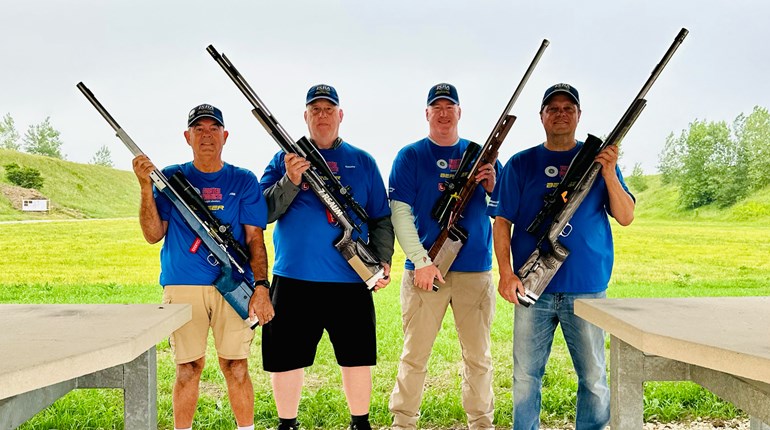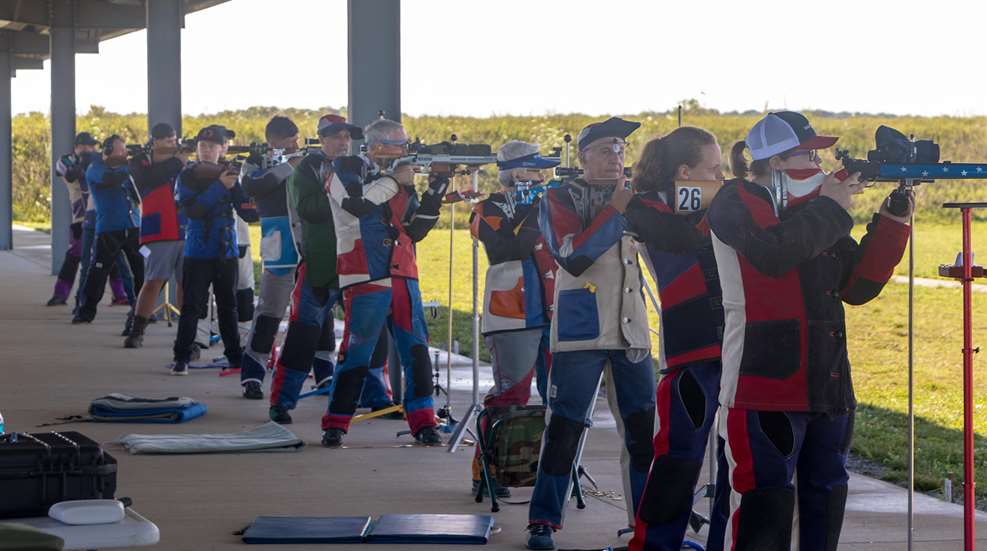
Shooting, like all other sports, is blessed with participants of varying skills so that over an extended series of meets, the same teams and individuals continually win. To equalize the distribution of awards and maintain a high degree of interest, various corrective systems have been developed.
One of these is the NRA Classification System, wherein competitors of near equal ability are grouped and compete for a class prize. Classification lends itself best to single competitions or to leagues of individuals. True handicap systems work best when the league winner is selected based on the number of matches won and not an aggregate score. Handicapping systems tend to reward improvement rather than overall consistent high performance of balanced teams. Some leagues meet the problem by balancing team membership so that raw scores fired by teams will be within a few points of each other.
TEAM BALANCING
Teams may be equalized by first listing participants in order of average and selecting the teams shown in the following sample. Team rosters for a single club’s four-team league:
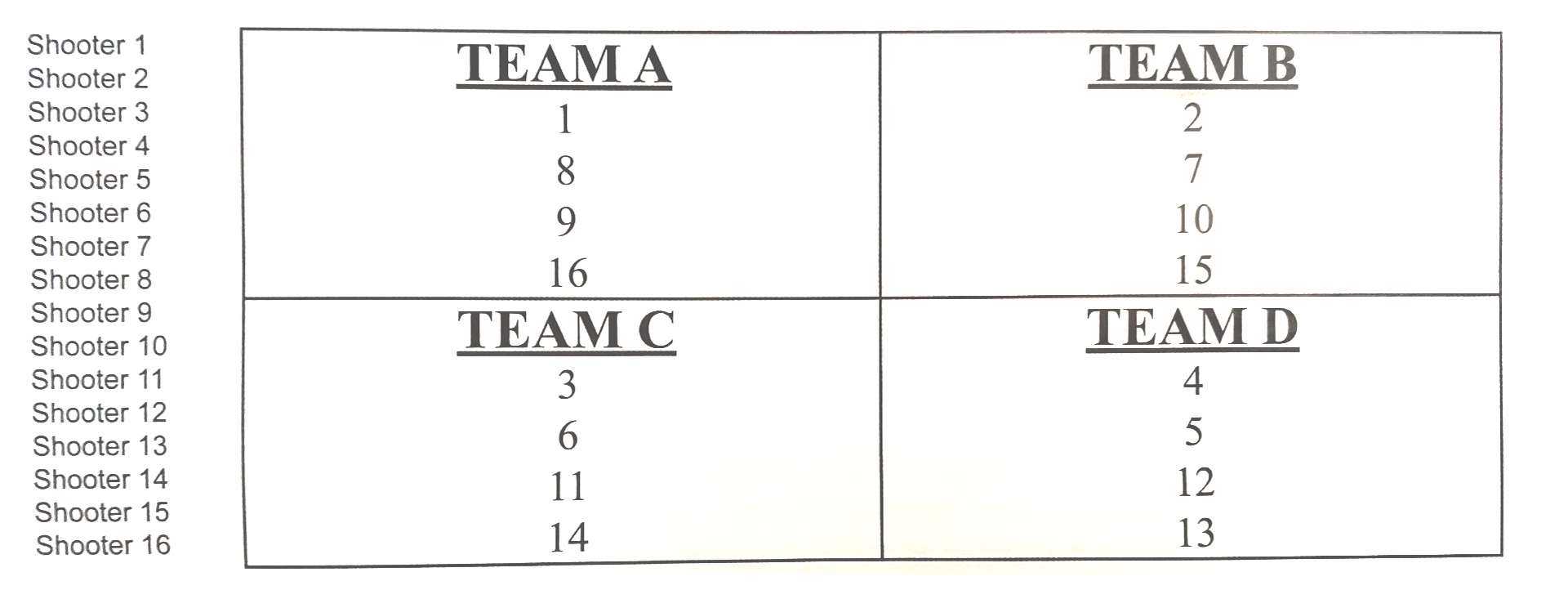
PERCENTAGE HANDICAPS
More league sports are handicapped under the percentage system than any other. Team Captains keep the averages for the shooters in their team. The average may be of all scores fired or it may be a rolling average, in which the average of scores fired in the last stated number of matches, usually three, is used. The average for team members is totaled for each team; the difference between two totals determined and the percentage of the difference, which was assigned at the beginning of the league season by the council, is awarded to the lower of two teams to be added to its score. Team Captains calculate the handicap prior to the start of the match. When the match is fired, the winner is the team who has the highest score including the handicap given the team with the lower average, even though the handicap score might exceed the perfect raw score for that course of fire. Handicaps are calculated to the nearest whole number.
DROPPED POINT SYSTEM
A Dropped Point System is based on a set of tables in which individual raw scores are converted to handicap scores. Handicap scores in the table are determined by comparison of the score fired to the shooter’s average score. Like other handicapping systems, the dropped point system rewards improvement. The system is best adapted for use in shoulder-to-shoulder league match operation, especially where a stated number of high scores from teams are used for the team score.
LEWIS HANDICAPPED SYSTEM
While called a handicap system, in reality it is a system of distributing prizes by chance. The number participating in a competition is divided by the number of prizes being offered. Prizes are then awarded based on relative standing in the match’s order of excellence. A prize awarded to the leading competitor in each group—in this case, those placing first, 11th, 21st, 31st and 41st—would receive prizes.
The Lewis System will work better with a league of individuals rather than teams. It is also possible to superimpose the system over a conventional award distribution plan. Such a combined plan might award the first three prizes to the top three winners with a number of other prizes distributed according to the Lewis System.
POT LUCK SYSTEM
This system is used primarily for novelty-type special events. Under this plan, a competitor selects whatever number of handicap points he or she wants before firing. These points are added to his fired score, and if the handicap points make a total of more than a possible score, the competitor is penalized two points for each point over a possible.
Example 1: A competitor selects a handicap of 20 points and fires in a 300 possible match. His or her score is 260 to which the 20 points are added, giving a total score of 280.
Example 2: A competitor selects a handicap of 20 points and fires in a 300 possible match. His or her score is 295 to which 20 points are added, giving a total of 315. This is 15 points more than a possible maximum score for that course of fire. This competitor is therefore penalized two points for each point over the possible, or 30 points penalty. Taking the 30 points from the possible 300 gives a handicapped score of 270.
A LEAGUE HANDICAP SYSTEM
The success or failure of any competitive league program is proportional to the interest displayed by the club members. Shoulder-to-shoulder league shooting is a satisfying way to enjoy shooting and helps to sustain interest and perpetuate the club. Two major factors to a successful league program are:
- Complete participation by all who want to shoot.
- Realistic workable handicap system.
Many leagues are composed of teams of four or five members. Team shooters are usually selected because they shoot the best scores in the club. This means that other members are not directly involved in competition. Establishing a second and perhaps a third team and entering each in the league schedule is only a partial answer. Because of rigid roster limits, newer shooters and less proficient shooters must wait for a vacancy on a team, which may involve an entire season’s wait. It is easy to see how interest might wane.
The ideal situation in league shooting is that in which:
- Every club member who wishes to shoot may do so, at any match.
- Teams of any skill and varying number participate.
- Every participant’s effort counts toward deciding the match.
A handicap system is used which gives the less skilled shooter an even chance without penalizing the higher scoring competitors.
For an example, use an indoor Smallbore Rifle position match (see below). The program works this way:
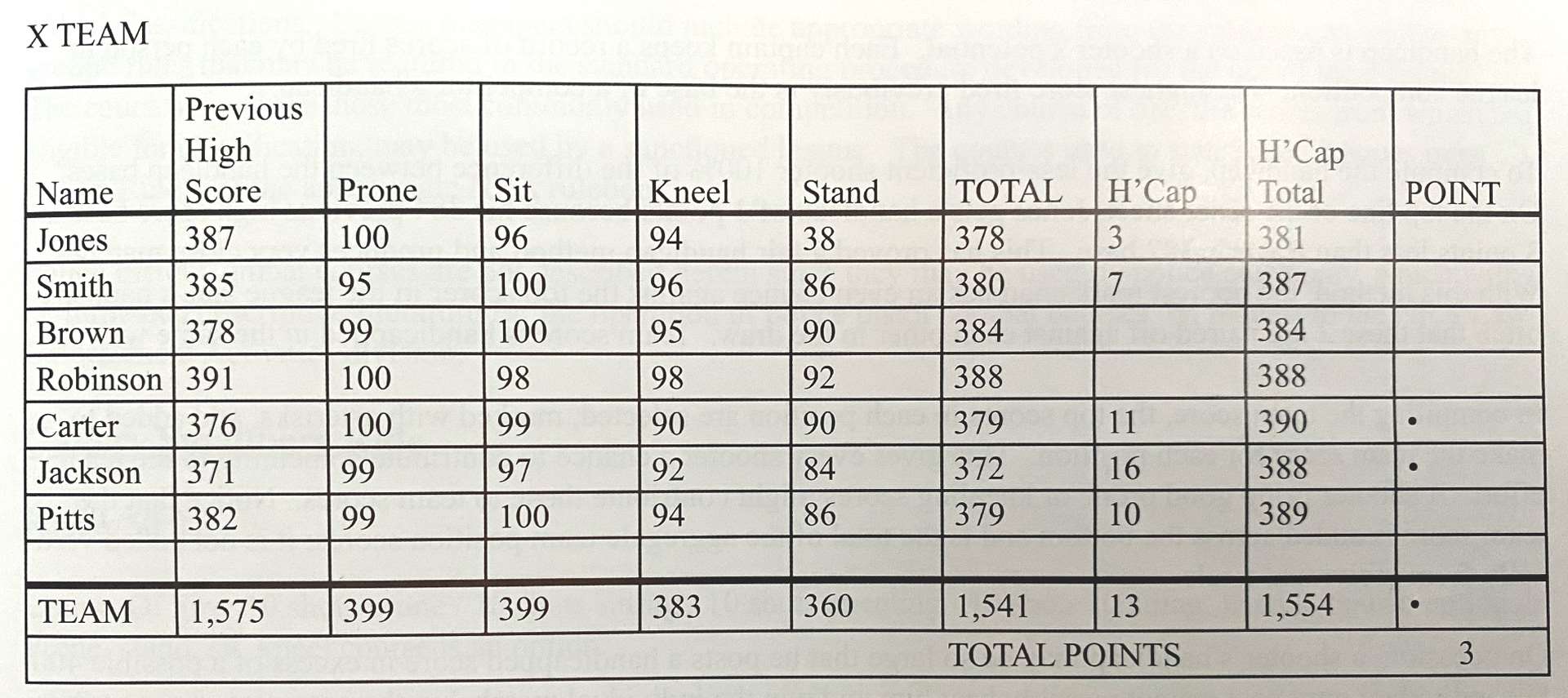
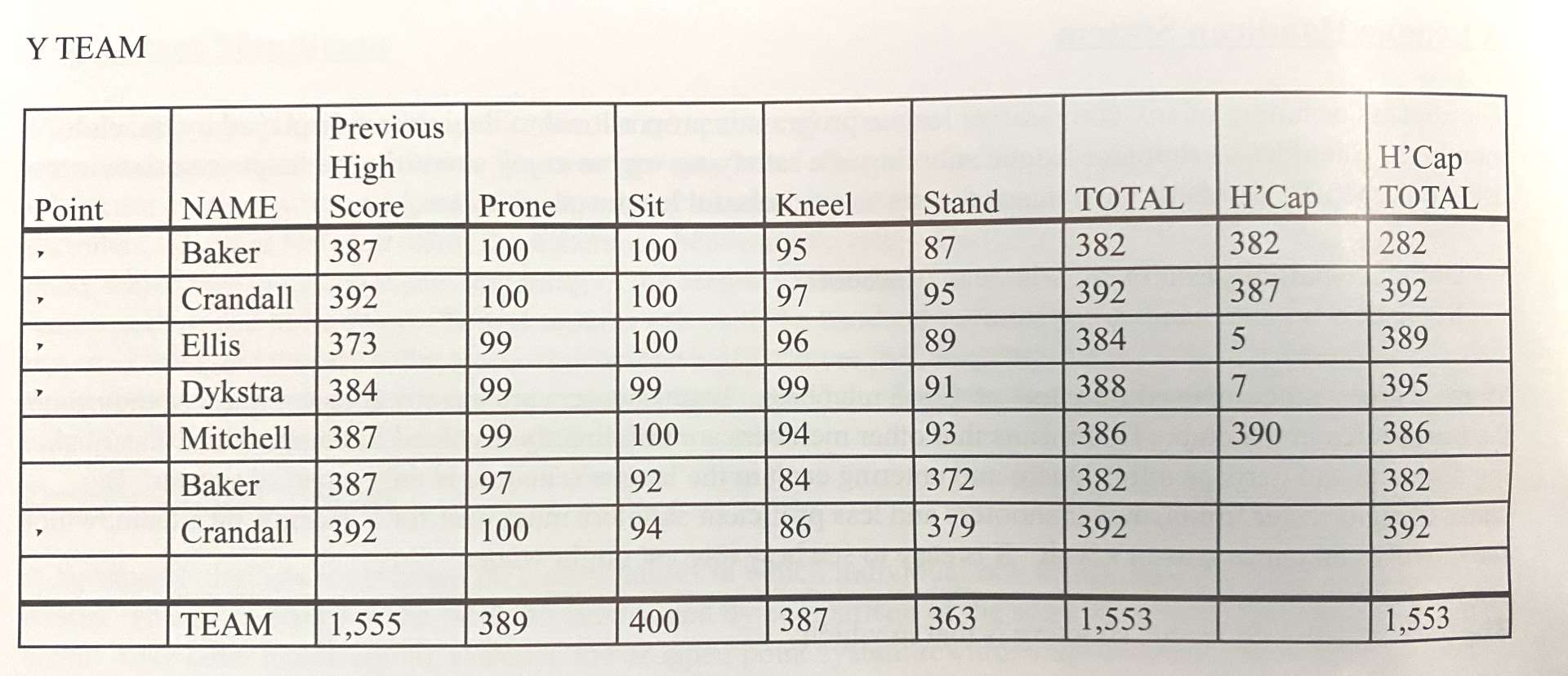
Two teams, X and Y, meet at X’s range for a scheduled league match and find that X team has seven shooters, but only five of Y teams shooters are present. The captain of the team having the most shooters present (X team) lists the shooters in any order. He or she lists also the previous high score each person has fired in league competition, taken from the captain’s record. These scores will be used to determine handicap.
Next, Y’s captain draws the name of his person from a hat and lists them in the order drawn. The five individuals are paired off against the first five shooters listed on X’s side of the score sheet for the individual matches. This leaves two of X’s shooters still unopposed, so the top names on Y’s roster are repeated until all X team’s competitors are opposed.
The handicap is based on a shooter’s potential. Each captain keeps a record of scores fired by each person in league competition. The highest score fired previously is the base of a competitor’s handicap.
To compute the handicap, give the less-proficient shooter 100 percent of the difference between the handicap bases. On the top line of the score sheet, Jones gets a handicap of three points because his 384 previous high score base is three points less than Baker’s 387 base. This has proved a fair handicap method and produces close matches. With this method, the poorest shooter has an even chance against the top scorer in the league, and it happens often that these two are paired off against each other in the draw. Team score is handicapped in the same way.
In compiling the team score, the top scores in each position are selected, marked with asterisks, and added to make the team score for each position. This gives every shooter a chance to contribute something to the team effort. A shooter firing good prone or kneeling scores might contribute those to team scores. Notice that the team score is added across the bottom and is the total of the aggregate team position scores; it is not added vertically from individual totals.
On occasion, a shooter’s handicap may be so large that he or she posts a handicapped score in excess of a possible 400. His or her individual opponent cannot possibly beat them and win the individual match, but the opponent can contribute to winning the team match by shooting high scores in each position. Thus, the better shooter’s efforts are never wasted. This occurs rarely, and the shooter who has fired the exceptional score will not likely repeat the performance soon, because he or she must thereafter use the high score fired as the handicap base. This system eliminates the problems that plague an “average” handicap system, where a rapidly improving shooter is unbeatable because his handicap is based on an average that includes earlier, much lower scores.
Team captains list the handicap bases, compute the differences and enter them in the space on the score sheet marked “H” Cap. This difference is entered only on the side of the individual whose “Previous High Score” is lower. When total individual scores are posted, the handicap is added, the two individual handicapped scores compared and the individual matches decided. A check mark is entered in the “Point” column for each individual winner and the number of check marks is totaled. The team score is treated in the same way as the individual scores and added in as one check mark. More points can be ascribed to the team score, so it counts more heavily in the final tally if desired. Add up the check marks and the match is decided.
The high standing score decides ties. In this example, if Jones of X team had one more point, he or she would have won the individual match on the basis of a higher standing score and would have thrown the match into a tie. But Y team has the high team standing score and would have won the match.
This system has been given a thorough trial in shoulder-to-shoulder league shooting. It is quickly grasped, works smoothly and generates a lot of interest among the shooters. It can be adapted for any type of league except Silhouette.
SPLIT SEASON
Split season might better be called a double schedule since it is a term applied to a league operation where winners are selected twice, usually at the completion of the first full series of matches between teams and again later when a second full series of matches has been fired. Season winners may then be selected by either a shoot-off between half season winners or league tournament.
For more information about NRA Competitive Shooting, go to competitions.nra.org.














